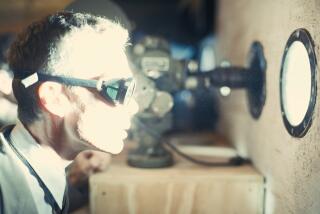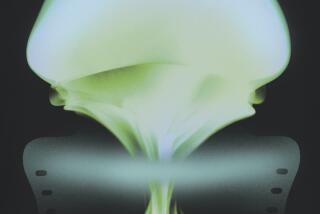Review: ‘Radioactive’s’ flashes of innovation are not enough to illuminate Marie Curie
- Share via
Radioactive: the discovery, the concept and the word defined culture in the 20th century, in the realms of science, medicine and war, and in our own existential dread and pop fantasies. The threat of nuclear warfare and nuclear meltdowns, the advances in treating cancer and the invention of the X-ray machine: It’s all become such a ubiquitous part of modern life that it’s important to remember the discovery itself came from a Polish woman living in France at the turn of the century, a wife and mother who battered the elements into submission seeking to understand how they worked.
Marie Curie was the first woman to win the Nobel Prize, and the first person and only woman to win it twice. Her life and work is the subject of Oscar-nominated filmmaker Marjane Satrapi’s fifth feature, “Radioactive,” adapted by Jack Thorne (“Dirt Music,” “The Aeronauts”) from Lauren Redniss’ nontraditional biography, “Radioactive: Marie & Pierre Curie: A Tale of Love and Fallout,” which she creatively illustrated. Rosamund Pike stars as the pioneering scientist who discovered radium and polonium with her husband, Pierre Curie (Sam Riley), thereby changing the world forever, for better or for worse.
The complicated legacy marks Satrapi’s film, which wrestles mightily with what Curie left us: radiation treatment for cancer and X-ray machines, but also Hiroshima and Chernobyl. The film is fixated to the point of obsession with that legacy, often leaping ahead to events that occurred decades after Curie’s death in 1934 to underline that, yes, radium is indeed an incredibly seductive and incredibly dangerous scientific discovery. A child receives cancer treatment; Chernobyl melts down.
The constant reminder feels a bit condescending to the audience and draws focus away from Curie herself. The filmmakers compulsively draw the connection between the Curies’ work and the destruction it eventually wreaked, cutting, for example, between Pierre’s Nobel acceptance speech and the Enola Gay dropping an atomic bomb on Hiroshima.
Satrapi brings flashes of creative, cinematic innovation in surreal moments of fantasy and magical realism peppered throughout. There’s even a quick glimpse of animation, the medium in which Satrapi first found acclaim with “Persepolis,” as the conception of Marie and Pierre‘s first child is rendered as an atom bursting. Another particularly remarkable sequence finds Marie in a haze after Pierre’s sudden and accidental death. Images of a grief-stricken Marie are overlaid with radioactively glowing images of her contemporary, modern dancer Loïe Fuller, who performed in an elaborate costume of billowing fabric, manipulating the material to emulate fire. Women who dared to play with fire: there’s something there, though “Radioactive” doesn’t quite complete the connection.
These flourishes, as well as some striking compositions shot by Anthony Dod Mantle, Danny Boyle’s regular cinematographer, breathe life into this otherwise staid telling of Curie’s life. Pike is predictably fantastic as the determined, almost obsessive to the point of self-destruction Curie. But despite the talent involved, and the incredible subject matter, the irritating tendency to overexplain means there’s very little spark to be found in the enervating “Radioactive.”
Katie Walsh is a Tribune News Service film critic.
‘Radioactive'
Rated: PG-13, for thematic elements, disturbing images, brief nudity and a scene of sensuality
Running time: 1 hour, 53 minutes
Playing: Available July 24 on Amazon Prime Video
More to Read
Only good movies
Get the Indie Focus newsletter, Mark Olsen's weekly guide to the world of cinema.
You may occasionally receive promotional content from the Los Angeles Times.










